
The four females and one male will be followed by researchers as they mate, lay eggs and hatch younglings to see how micro-gravity affects fertility. Specifically, the Gecko-F4 mission aims:
- Create the conditions for sexual activity, copulation and reproduction of geckos in orbit
- Film the geckos’ sex acts and potential egg-laying and maximise the likelihood that any eggs survive
- Detect possible structural and metabolic changes in the animals, as well as any eggs and foetuses
As if enough eyes weren’t enough, the geckos will be kept company by Drosophila fruit flies, as well as mushrooms, plant seeds and various microorganisms that are also being studied. In the chamber next to this tiny ecosystem lies a furnace were melting and solidification of metal alloys in space will be studied. After the two month study is over, Roscosmos plans on running addition experiments before its eventual Earth uncontrolled re-entry four months later.
[ALSO READ] Gecko-like robot climbs walls effortlessly
This, of course, assuming contact isn’t lost again. The Russian space agency was quoted saying the most probable cause of the initial communications failure may have been space debris. The satellite that carries the experiment is flying in low-orbit at around 357 miles away from the Earth’s surface. Here, the gecko ferrying satellite shares orbit with the International Space Station and around 20,000 space debris. We’ve written extensively in the past on the dangers space debris pose to space missions and how we might possibly tackle them.
If mankind is ever to become an interstellar race, some humans will most certainly spend their lifetimes in space. Trips might last for whole generations in fact. It becomes thus important to understand what kind of effects zero gravity has on mating and fertility. If, for instance, across many generations maybe, it’s found that humans can’t reproduce in space this would spell a disaster. Geckos are part of a bigger plan meant to probe this very important question. They’re not the first beings to mate in space, though. This honor belongs to a cockroach!
In 2007, Roscosmos sent a crew of geckos, newts, snails, Mongolian gerbils and cockroaches to space and landed the experiment back on Earth 12 days later. The cockroaches were the first to mate in space, and researchers were able to identify which of them was the first to conceive in space – a cockroach named Nadezhda, which means “hope” in Russian. Interestingly enough, the roaches “run faster than ordinary cockroaches, and are much more energetic and resilient”, according to Russian researchers.









